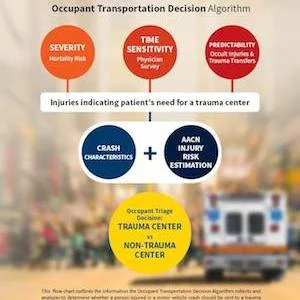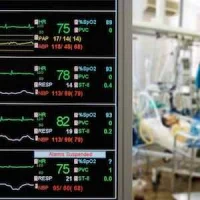Getting motor vehicle crash victims to the most appropriate healthcare facility may be easier in future, with the assistance of a computer algorithm developed by a team of biomechanical specialists and clinicians at Wake Forest University, Winston-Salem, North Carolina. The researchers developed the Occupant Transportation Decision Algorithm (OTDA) that collects information using data from recorders that are available on motor vehicles. They estimate that if implemented nationwide there would be a potential benefit of improved triage decision making for 165,000 occupants involved in crashes annually. The study is published in the Journal of the American College of Surgeons in advance of print.
The OTDA is an Advanced Automatic Crash Notification (AACN) algorithm that uses vehicle telemetry measurements, such as those from an event data recorder, to predict risk of serious injuries in vehicle crashes from information such as seatbelt use, airbag deployment, speed and the point of impact --side, head-on, rear or rollover. This information can help healthcare staff and paramedics determine the location and severity of injuries. The algorithm was developed with analysis of large hospital and survey datasets with information on injuries, mortality risk, treatment urgency, and hospital transfers as well as crash datasets that include data on the crash, vehicle, occupant and injury.
"This algorithm has the potential to inform the risk of severe injury for people in a crash, and their risk is different depending on whether they're properly belted in a crash or have the benefit of an airbag; that's what emergency medical services personnel are looking for at a crash scene," said lead study author Joel D. Stitzel, PhD, of the Virginia Tech-Wake Forest University Center for Injury Biomechanics. "That's what automobile manufacturers and scientists really need to be thinking about: Does the patient need to be cared for at a Level I or Level II trauma centre or can they go somewhere else, to a regional hospital, for example?"
There are other algorithms used to grade the extent of injuries or risk of injury in a crash. The OTDA adds to these by including time sensitivity-how quickly the injuries need to be addressed--and predictability factors.
The researchers evaluated the new algorithm in a model on two measures: overtriage and undertriage. The OTDA achieved an overtriage rate of below 50 percent in all crash types, and undertriage rates below 5 percent in side-impact crashes and ranging from 6-16 percent in other types of crashes. The researchers estimate that nationwide implementation of this algorithm would correct triage decisions for 44 percent of those who are undertriaged and 38 percent of those who are overtriaged. That scenario would translate into more appropriate care for more than 2,700 seriously injured crash victims annually, and avoid sending more than 162,000 people who don't need trauma-level care to trauma centres.
"The best data we have says that the current system for motor vehicle crashes overtriages crash victims at a rate of around 60 percent, and the American College of Surgeons guidelines call for around 50 percent," Dr. Stitzel said. "So we're currently sending a lot of crash victims to the trauma centre who don't necessarily need to go there at a rate higher than what experts would recommend."
See Also: Electronic Trauma Health Record App Premieres at Trauma Center
"Undertriage is probably the worst thing you can do for a patient because you're sending someone to a lower level of care when they need a higher level of care," Dr. Stitzel said. "It can result in delayed care and missed injuries as a result."
The authors conclude: ” The OTDA appears to be doing more with less than several algorithms with which it has been compared and shows great promise as an improved approach for triaging patients. Additional reduction in under-triage and over-triage would be expected if additional variables, such as occupant age and sex, were included in the OTDA.”
The study was funded by Toyota Motor Corporation and Toyota's Collaborative Safety Research Center in Ann Arbor, Michigan.
Source and image credit: American College of Surgeons
Image: This flow chart outlines the information the Occupant Transportation Decision Algorithm collects and analyses to determine whether a person injured in a motor vehicle crash should be sent to a trauma centre or hospital emergency room.
The OTDA is an Advanced Automatic Crash Notification (AACN) algorithm that uses vehicle telemetry measurements, such as those from an event data recorder, to predict risk of serious injuries in vehicle crashes from information such as seatbelt use, airbag deployment, speed and the point of impact --side, head-on, rear or rollover. This information can help healthcare staff and paramedics determine the location and severity of injuries. The algorithm was developed with analysis of large hospital and survey datasets with information on injuries, mortality risk, treatment urgency, and hospital transfers as well as crash datasets that include data on the crash, vehicle, occupant and injury.
"This algorithm has the potential to inform the risk of severe injury for people in a crash, and their risk is different depending on whether they're properly belted in a crash or have the benefit of an airbag; that's what emergency medical services personnel are looking for at a crash scene," said lead study author Joel D. Stitzel, PhD, of the Virginia Tech-Wake Forest University Center for Injury Biomechanics. "That's what automobile manufacturers and scientists really need to be thinking about: Does the patient need to be cared for at a Level I or Level II trauma centre or can they go somewhere else, to a regional hospital, for example?"
There are other algorithms used to grade the extent of injuries or risk of injury in a crash. The OTDA adds to these by including time sensitivity-how quickly the injuries need to be addressed--and predictability factors.
The researchers evaluated the new algorithm in a model on two measures: overtriage and undertriage. The OTDA achieved an overtriage rate of below 50 percent in all crash types, and undertriage rates below 5 percent in side-impact crashes and ranging from 6-16 percent in other types of crashes. The researchers estimate that nationwide implementation of this algorithm would correct triage decisions for 44 percent of those who are undertriaged and 38 percent of those who are overtriaged. That scenario would translate into more appropriate care for more than 2,700 seriously injured crash victims annually, and avoid sending more than 162,000 people who don't need trauma-level care to trauma centres.
"The best data we have says that the current system for motor vehicle crashes overtriages crash victims at a rate of around 60 percent, and the American College of Surgeons guidelines call for around 50 percent," Dr. Stitzel said. "So we're currently sending a lot of crash victims to the trauma centre who don't necessarily need to go there at a rate higher than what experts would recommend."
See Also: Electronic Trauma Health Record App Premieres at Trauma Center
"Undertriage is probably the worst thing you can do for a patient because you're sending someone to a lower level of care when they need a higher level of care," Dr. Stitzel said. "It can result in delayed care and missed injuries as a result."
The authors conclude: ” The OTDA appears to be doing more with less than several algorithms with which it has been compared and shows great promise as an improved approach for triaging patients. Additional reduction in under-triage and over-triage would be expected if additional variables, such as occupant age and sex, were included in the OTDA.”
The study was funded by Toyota Motor Corporation and Toyota's Collaborative Safety Research Center in Ann Arbor, Michigan.
Source and image credit: American College of Surgeons
Image: This flow chart outlines the information the Occupant Transportation Decision Algorithm collects and analyses to determine whether a person injured in a motor vehicle crash should be sent to a trauma centre or hospital emergency room.
References:
Stitzel JD, Weaver AA, Talton JW, Barnard RT, Schoell SL, Doud AN,
Martin RS, Meredith JW (2016) An injury severity-, time sensitivity-, and predictability-based advanced automatic crash notification algorithm improves motor vehicle crash occupant triage. J Am Coll Surg., pii:
S1072-7515(16)30031-X. doi: 10.1016/j.jamcollsurg.2016.03.028. [Epub
ahead of print]
Latest Articles
Triage, accidents, algorithms
Getting motor vehicle crash victims to the most appropriate healthcare facility may be easier in future, with the assistance of a computer algorithm developed by a team of biomechanical specialists and clinicians at Wake Forest University, Winston-Salem,










